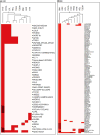Are there genetic paths common to obesity, cardiovascular disease outcomes, and cardiovascular risk factors?
- PMID: 25722444
- PMCID: PMC4416656
- DOI: 10.1161/CIRCRESAHA.116.302888
Are there genetic paths common to obesity, cardiovascular disease outcomes, and cardiovascular risk factors?
Abstract
Clustering of obesity, coronary artery disease, and cardiovascular disease risk factors is observed in epidemiological studies and clinical settings. Twin and family studies have provided some supporting evidence for the clustering hypothesis. Loci nearest a lead single nucleotide polymorphism (SNP) showing genome-wide significant associations with coronary artery disease, body mass index, C-reactive protein, blood pressure, lipids, and type 2 diabetes mellitus were selected for pathway and network analyses. Eighty-seven autosomal regions (181 SNPs), mapping to 56 genes, were found to be pleiotropic. Most pleiotropic regions contained genes associated with coronary artery disease and plasma lipids, whereas some exhibited coaggregation between obesity and cardiovascular disease risk factors. We observed enrichment for liver X receptor (LXR)/retinoid X receptor (RXR) and farnesoid X receptor/RXR nuclear receptor signaling among pleiotropic genes and for signatures of coronary artery disease and hepatic steatosis. In the search for functionally interacting networks, we found that 43 pleiotropic genes were interacting in a network with an additional 24 linker genes. ENCODE (Encyclopedia of DNA Elements) data were queried for distribution of pleiotropic SNPs among regulatory elements and coding sequence variations. Of the 181 SNPs, 136 were annotated to ≥ 1 regulatory feature. An enrichment analysis found over-representation of enhancers and DNAse hypersensitive regions when compared against all SNPs of the 1000 Genomes pilot project. In summary, there are genomic regions exerting pleiotropic effects on cardiovascular disease risk factors, although only a few included obesity. Further studies are needed to resolve the clustering in terms of DNA variants, genes, pathways, and actionable targets.
Keywords: cluster analysis; gene networks; genetic pleiotropism.
© 2015 American Heart Association, Inc.
Conflict of interest statement
Figures




References
-
- Physical Activity Guidelines Advisory Committee. Physical Activity Guidelines Advisory Committee Report, 2008. Washington, DC: U.S. Department of Health and Human Services; 2008. - PubMed
-
- Bouchard C, Perusse L. Genetics of causes and manifestations of the metabolic syndrome. In: Crepaldi G, editor. 6th European Symposium on Metabolism: The Plurimetabolic Syndrome. Amsterdam, The Netherlands: Elsevier Science Publishers; 1994.
-
- Nelson TL, Vogler GP, Pedersen NL, Hong Y, Miles TP. Genetic and environmental influences on body fat distribution, fasting insulin levels and CVD: are the influences shared? Twin Res. 2000;3:43–50. - PubMed
Publication types
MeSH terms
Grants and funding
- 1R21DK088319-01/DK/NIDDK NIH HHS/United States
- 1 U54 GM104940/GM/NIGMS NIH HHS/United States
- 10SDG4230068/AHA/American Heart Association-American Stroke Association/United States
- P20 RR021945/RR/NCRR NIH HHS/United States
- R21 DK088319/DK/NIDDK NIH HHS/United States
- U54 GM104940/GM/NIGMS NIH HHS/United States
- HL045670/HL/NHLBI NIH HHS/United States
- P20 MD000175/MD/NIMHD NIH HHS/United States
- P30 GM118430/GM/NIGMS NIH HHS/United States
- R01 HL045670/HL/NHLBI NIH HHS/United States
- P20 GM103528/GM/NIGMS NIH HHS/United States
- P20MD000175-09/MD/NIMHD NIH HHS/United States
LinkOut - more resources
Full Text Sources
Medical
Research Materials

